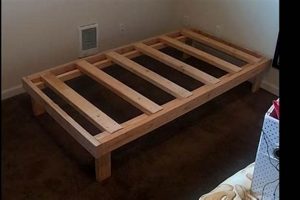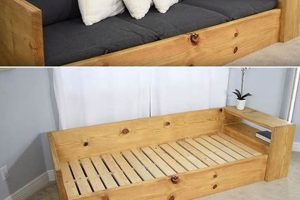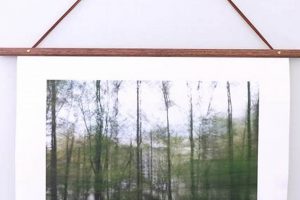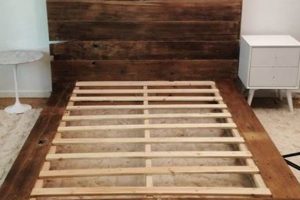Constructing a bed frame with a focus on raw, natural materials and a handcrafted aesthetic is a popular approach to bedroom furnishing. This method typically involves utilizing reclaimed wood, simple joinery techniques, and a minimal amount of ornamentation to achieve a relaxed, unpolished appearance. An example would be a frame built from salvaged barn wood, showcasing visible nail holes and imperfections, finished with a matte sealant to preserve its character.
This style of bed frame offers several advantages, including cost-effectiveness through the use of readily available or repurposed materials. Furthermore, it allows for a high degree of personalization, enabling individuals to tailor the dimensions and design to their specific needs and aesthetic preferences. Historically, such approaches to furniture construction reflect a connection to traditional craftsmanship and a sustainable mindset focused on reducing waste and embracing the beauty of imperfection.
The following sections will detail specific material selections, construction methodologies, finishing techniques, and design considerations relevant to building a distinctive and durable sleep platform following this approach. These guidelines aim to equip individuals with the knowledge necessary to realize their vision for a unique bedroom centerpiece.
Essential Considerations for a Handmade, Natural Bed Support
The following guidelines offer practical advice for achieving a structurally sound and aesthetically pleasing bed frame through independent construction.
Tip 1: Material Selection. Prioritize seasoned lumber to minimize warping or cracking after assembly. Reclaimed wood offers character, but thorough inspection for insects and rot is essential. Consider species hardness based on the intended design’s structural demands.
Tip 2: Accurate Measurements. Precisely measure the mattress dimensions before cutting any lumber. Account for potential settling or expansion to ensure a snug but not overly tight fit within the completed frame. Double-check all measurements before each cut.
Tip 3: Robust Joinery. Employ mortise-and-tenon, dovetail, or strong screw connections combined with wood glue to ensure frame stability. Weak joints compromise the structural integrity and longevity of the finished product. Reinforce corners for added support.
Tip 4: Strategic Support. Integrate center support beams or slats, especially for larger mattresses or designs intended to withstand significant weight. Insufficient support can lead to mattress sagging and eventual frame failure. Consider the load-bearing capacity of each element.
Tip 5: Thoughtful Finishing. Apply a protective sealant or finish to safeguard the wood from moisture and wear. Choose a low-VOC product to minimize off-gassing and promote a healthier sleep environment. Sand surfaces smooth before applying any finish.
Tip 6: Hardware Integration. Select appropriate fasteners and hardware that complement the overall aesthetic. Black iron or antique brass hardware can enhance the raw aesthetic. Ensure all hardware is securely fastened and countersunk to avoid sharp edges.
Tip 7: Proportional Design. Maintain visual balance and proportion in the frame’s design. Avoid excessively thick or thin elements that might appear disproportionate or structurally unsound. Consider the overall room dimensions and style when determining the frame’s size and scale.
Adherence to these principles will result in a durable, aesthetically pleasing, and functional bed frame constructed with a focus on natural materials and handcrafted techniques.
The subsequent section will address common challenges encountered during the assembly process and offer practical solutions.
1. Wood Selection
The selection of wood fundamentally dictates the aesthetic and structural integrity of a bed frame project. Different wood species offer distinct characteristics that affect the final product’s appearance, durability, and workability. For instance, using reclaimed barn wood contributes significantly to a frame’s rustic aesthetic. However, this material requires meticulous inspection to ensure it is free from insect infestation or rot, issues that could compromise the frame’s longevity. Softwoods like pine are easier to work with for less experienced builders, but they may dent or scratch more easily than hardwoods. A lack of careful consideration in this phase will affect the result.
Hardwoods such as oak or maple offer greater strength and resistance to wear, making them suitable for larger beds or those intended for heavy use. However, they demand more specialized tools and techniques for cutting and shaping. The choice between rough-sawn lumber, which retains a more natural appearance, and planed lumber, which offers a smoother, more refined surface, also affects the final aesthetic. A project employing rough-sawn oak, minimally sanded and finished with a matte sealant, will possess a distinctly different character from one constructed of planed pine and coated with a glossy varnish.
Ultimately, the wood selection must align with the desired aesthetic, the builder’s skill level, and the project’s budget. Neglecting these considerations can lead to structural weaknesses, visual inconsistencies, or increased costs. A thorough understanding of wood properties and their impact on the project is essential for a successful outcome, where the visual and functional aspects are meet the need.
2. Frame Dimensions
Accurate frame dimensions are paramount to the successful construction of a functional and aesthetically pleasing bed frame. The interior dimensions must precisely accommodate the intended mattress size; discrepancies will result in either a mattress that is too loose within the frame, leading to instability and potential shifting during use, or one that is too tight, causing compression and premature wear. Real-world examples include instances where a frame constructed based on assumed dimensions, rather than precise measurements of the mattress, resulted in a mattress overhang or, conversely, a significant gap between the mattress and the frame rails. The structural integrity and visual appeal are directly determined by dimension accuracy.
The external dimensions influence the overall footprint of the bed within the room, thereby impacting traffic flow and spatial harmony. Oversized frames in small spaces can impede movement and create a sense of clutter. In contrast, a frame that is too small can appear visually unbalanced. Furthermore, the height of the frame, determined by its dimensions, affects ease of access and the overall aesthetic. Lower frames often contribute to a more modern or minimalist style, while taller frames, particularly those incorporating a platform base, can provide additional storage space. As an example, consider a room with low ceilings; a taller frame would exacerbate the feeling of confinement, whereas a lower profile would enhance the sense of space.
In conclusion, meticulously planned and executed frame dimensions are fundamental to the functionality, aesthetics, and spatial integration of the finished bed frame. The precision in these initial measurements dictates the final outcome, necessitating careful consideration of both the mattress size and the surrounding environment. Addressing potential challenges in dimensional planning minimizes the risk of wasted materials and structural or aesthetic compromises, aligning with the goals of a functional and visually appealing result.
3. Joint Strength
Joint strength is a critical determinant of a bed frame’s longevity and structural integrity, particularly in the context of a bed frame. The inherent irregularities and potential imperfections present in reclaimed wood or rustic construction techniques demand robust joinery to compensate for variations in material density and shape. Inadequate joint strength can lead to frame instability, manifested as wobbling, creaking, or, in extreme cases, complete structural failure. For instance, a frame constructed using only nails and screws, without the reinforcement of interlocking joinery like mortise and tenon or dovetail joints, is likely to loosen over time, especially under the constant stress of weight and movement. This outcome directly compromises the bed’s functionality and safety.
The choice of joinery technique significantly impacts the overall stability of the bed. While simpler methods such as butt joints secured with screws might suffice for decorative elements, load-bearing joints require more sophisticated approaches. Mortise and tenon joints, where a protruding tenon fits snugly into a corresponding mortise, provide exceptional resistance to shear forces. Dovetail joints, with their interlocking wedge shape, offer superior tensile strength, preventing the joint from pulling apart under stress. The application of high-quality wood glue in conjunction with these mechanical joints further enhances their strength and durability. An example of this would be reinforcing the corners of the frame, where stress is concentrated, with dovetail joints complemented by epoxy resin, ensuring long-term structural reliability.
In summary, the relationship between joint strength and the overall quality of a bed frame is undeniable. The selection and execution of appropriate joinery techniques directly affect the frame’s ability to withstand daily use and maintain its structural integrity over time. While the aesthetic of a bed frame may prioritize a raw or unrefined appearance, compromising on joint strength can lead to premature failure and safety concerns. Therefore, a thorough understanding of joinery principles and their application is essential for anyone undertaking such a project, ensuring a finished product that is both visually appealing and structurally sound.
4. Support Structure
The support structure within a bed frame is paramount to its functionality and longevity, particularly when engaging in a project focusing on creating a frame at home. The design and implementation of an adequate support system directly influence the frame’s ability to withstand weight, prevent mattress sagging, and maintain overall stability. This element is crucial for ensuring comfortable and safe sleep.
- Center Support Beam(s)
The inclusion of a center support beam, or multiple beams for larger frames, provides crucial reinforcement along the mattress’s central axis. Without this support, the mattress is prone to sagging, which can lead to discomfort and reduced lifespan of both the mattress and the frame. In a homemade bed frame, this can be achieved by adding a lengthwise beam attached to the headboard and footboard with sturdy brackets or mortise-and-tenon joints. An inadequate center support often results in a noticeable dip in the mattress and potential frame failure over time.
- Slat System
The slat system forms the immediate foundation for the mattress. Slats, typically made of wood, are spaced evenly across the frame to distribute weight and allow for ventilation. The type of wood used for slats, their thickness, and the spacing between them significantly impact the support provided. For example, using thin, widely spaced slats on a frame intended for a heavy memory foam mattress will likely lead to sagging and uneven support. A well-designed slat system employs sturdy slats spaced closely together to provide consistent support across the entire mattress surface.
- Leg Placement and Reinforcement
The placement and construction of the bed frame’s legs directly affect its stability. Legs should be positioned strategically at the corners and along the sides of the frame to distribute weight evenly. Reinforcing the leg attachments with corner brackets, screws, and glue strengthens the overall structure. A common oversight is using insufficient legs or inadequate attachment methods, which can cause the frame to wobble or even collapse under weight. Strong, well-placed legs are essential for a stable and reliable bed frame.
- Material Compatibility
The materials used for the support structure must be compatible with the overall design and weight requirements of the bed frame. Using flimsy or inadequate materials for critical support elements will compromise the frame’s integrity. For instance, constructing a support structure from thin, untreated pine for a frame intended to support a heavy box spring mattress is likely to result in structural failure. Choosing appropriate materials based on their strength and load-bearing capacity is essential for a durable and safe bed frame.
These facets of support structure are interconnected and contribute to the overall quality of a frame project. Neglecting any one of these aspects can significantly compromise the bed frame’s stability, comfort, and longevity. A focus on proper design, material selection, and construction techniques for the support system is essential for ensuring a durable and functional bed frame.
5. Finishing Techniques
Finishing techniques are integral to the aesthetic preservation and structural longevity of a bed frame project. These techniques protect the wood from moisture, wear, and environmental factors, while simultaneously enhancing its visual appeal, ensuring the frame’s durability and long-term value. The choice of finish significantly impacts the frame’s overall aesthetic and its ability to withstand the rigors of daily use.
- Sealing
Sealing is a critical initial step that protects the wood from absorbing moisture and prevents the development of mold and mildew. A properly sealed frame resists warping, cracking, and other forms of damage caused by humidity and temperature fluctuations. For a frame, polyurethane or varnish sealants are commonly employed to create a durable, water-resistant barrier. Improper sealing can lead to premature decay and structural instability, particularly in humid environments.
- Staining
Staining enhances the wood’s natural grain and color, allowing for customization of the frame’s aesthetic. Different stain colors can evoke different moods and complement the overall design of the bedroom. For a bed frame, oil-based or water-based stains are frequently used to achieve the desired color depth and saturation. Uneven application or the use of incompatible stains can result in blotchy or inconsistent coloration, detracting from the frame’s visual appeal.
- Protective Coatings
Protective coatings, such as varnish or lacquer, provide a durable layer of protection against scratches, dents, and other forms of physical damage. These coatings safeguard the finish from wear and tear, extending the frame’s lifespan. For high-traffic areas or surfaces prone to contact, multiple coats of a protective coating are recommended to ensure adequate protection. Insufficient protection can lead to surface damage and the need for frequent refinishing.
- Distressing
Distressing techniques, such as sanding, scraping, or applying antiquing glazes, are often employed to enhance the frame’s rustic character. These techniques create a weathered appearance, mimicking the effects of age and wear. For a bed frame, distressing can be applied selectively to emphasize the frame’s unique features and create a sense of history. Over-distressing or inconsistent application can result in a contrived or artificial appearance, diminishing the frame’s authenticity.
In conclusion, the selection and application of appropriate finishing techniques are crucial for both the aesthetic appeal and long-term durability of a bed frame project. A well-executed finish not only enhances the frame’s visual character but also protects it from the elements, ensuring its longevity and value. Disregarding these techniques can lead to premature wear, aesthetic degradation, and the need for costly repairs or replacements.
6. Design Aesthetics
Design aesthetics, in the context of bed frame projects, directly influences the visual appeal and overall harmony of the piece within a bedroom setting. The intentional application of design principles elevates a functional structure into a cohesive element that complements or defines the room’s character, ensuring the end product is both structurally sound and visually pleasing.
- Proportion and Scale
Proportion refers to the relative size and balance of elements within the frame. A bed frame that is disproportionately large or small in relation to the mattress or the room it occupies disrupts visual harmony. Scale, similarly, relates to the overall size of the frame and its compatibility with the surrounding space. Examples include a low-profile frame in a room with high ceilings, which can appear insignificant, or an excessively tall frame in a small bedroom, which can feel overwhelming. Achieving appropriate proportion and scale is essential for creating a visually balanced and comfortable environment.
- Material Selection and Texture
The choice of materials and their inherent textures significantly contributes to the frame’s aesthetic. Using reclaimed wood with visible knots and grain patterns enhances its character, while smooth, polished surfaces create a more refined look. The juxtaposition of different textures, such as pairing rough-sawn lumber with metal accents, adds visual interest. However, the selection should align with the desired aesthetic; for instance, incorporating highly polished metal into a frame intended to evoke a rustic feel would create a visual discord. Harmonious material selection is vital for a cohesive aesthetic.
- Color Palette
Color plays a crucial role in establishing the frame’s visual impact and its integration with the room’s decor. Natural wood tones convey warmth and authenticity, while darker stains add sophistication and drama. The choice of color should complement the existing color palette of the bedroom and create a sense of visual unity. Contrasting colors can be used to create focal points, but an overabundance of conflicting colors can result in a chaotic and disjointed aesthetic. A carefully considered color palette enhances the frame’s visual appeal and its integration with the overall space.
- Style and Theme
The chosen style or theme should reflect the desired aesthetic and complement the overall design of the room. A frame evoking a farmhouse style might incorporate elements like distressed wood, simple lines, and neutral colors. Conversely, a more modern design might feature sleek lines, minimalist details, and dark finishes. The consistent application of a specific style or theme ensures a cohesive and intentional aesthetic. Deviating from the chosen style can lead to a muddled and unrefined appearance. Adhering to a well-defined style enhances the frame’s visual impact and its contribution to the overall design narrative of the space.
These facetsproportion, material texture, color, and stylistic themeare interconnected. Each contributes significantly to a frame’s design and its integration within the room. A thoughtful approach to each consideration yields a cohesive and visually compelling result, enriching the aesthetic of the bedroom. These elements, when meticulously combined, ensure the final product is not only structurally sound but also aesthetically congruent with the surrounding environment, fulfilling both functional and visual requirements.
Frequently Asked Questions
The following section addresses common inquiries regarding the construction of bed frames emphasizing raw materials and handcrafted aesthetics.
Question 1: What wood types are most suitable for achieving a desirable appearance?
Reclaimed barn wood, pine, oak, and maple are frequently employed. Reclaimed wood offers a weathered aesthetic, while pine provides ease of workability. Oak and maple offer enhanced durability. The selection should align with the desired aesthetic and structural requirements.
Question 2: How can structural integrity be ensured when utilizing reclaimed lumber?
Thorough inspection for rot and insect infestation is imperative. Reinforcement with robust joinery techniques, such as mortise and tenon or dovetail joints, is also crucial to compensate for potential material weaknesses.
Question 3: What are the critical dimensions to consider when planning the frame?
The interior dimensions must precisely accommodate the mattress size to prevent shifting or compression. The exterior dimensions must also be considered, to be proportional in the space, and not block traffic, or have a small frame in a large room.
Question 4: What joinery methods are recommended for ensuring a stable and durable frame?
Mortise and tenon, dovetail joints, and strong screw connections combined with wood glue are advisable. These methods offer superior resistance to stress and prevent the frame from loosening over time.
Question 5: How can mattress sagging be prevented?
The integration of a center support beam or multiple beams, along with a well-designed slat system featuring evenly spaced slats, is critical. These elements distribute weight and provide uniform support across the mattress surface.
Question 6: What finishing techniques are most effective for protecting the wood and enhancing its appearance?
Sealing the wood is essential for preventing moisture damage. Staining can enhance the natural grain and color, while protective coatings like varnish or lacquer provide resistance to scratches and wear. Distressing techniques can enhance the weathered aesthetic. Distressing techniques can be combined to enhance the weathered appearance, should that be desired.
The key takeaways emphasize material selection, robust joinery, accurate dimensions, adequate support, and appropriate finishing as essential elements of a successful project.
The subsequent section will provide detailed, step-by-step construction guidance.
Conclusion
This exploration has detailed the essential considerations for successfully undertaking a project focusing on a bed frame with raw materials and a handcrafted look. Key aspects include careful wood selection, precise dimensional planning, robust joinery techniques, strategic support structure implementation, and appropriate finishing methods. Attention to these details contributes significantly to the creation of a durable and aesthetically appropriate piece.
The information presented offers a foundation for constructing a functional and visually appealing sleeping platform. A thorough understanding and application of these principles will enable individuals to produce a durable and individualized centerpiece for their bedroom, reflecting both practicality and an appreciation for handcrafted design.







